The Spoil Detection Based Smart Label Market is estimated to be valued at USD 3.4 billion in 2025 and is projected to reach USD 11.5 billion by 2035, registering a compound annual growth rate (CAGR) of 12.8% over the forecast period.
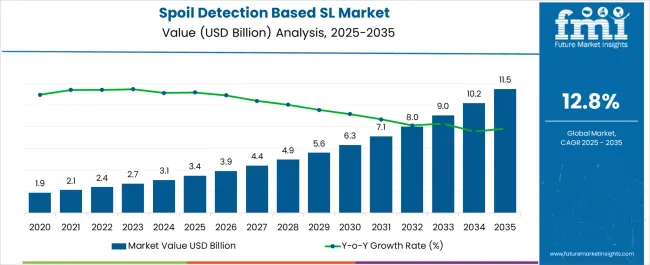
| Metric | Value |
|---|---|
| Spoil Detection Based Smart Label Market Estimated Value in (2025 E) | USD 3.4 billion |
| Spoil Detection Based Smart Label Market Forecast Value in (2035 F) | USD 11.5 billion |
| Forecast CAGR (2025 to 2035) | 12.8% |
The spoil detection based smart label market is gaining momentum as global concerns around food safety, supply chain efficiency, and waste reduction continue to intensify. These labels are being increasingly adopted due to their ability to provide real-time information on product freshness, enabling both retailers and consumers to make informed decisions. Rising incidences of foodborne illnesses and stricter regulatory frameworks on food safety standards are reinforcing the need for advanced monitoring solutions.
Technological progress in biosensors, nanomaterials, and printed electronics is enhancing the accuracy and affordability of spoil detection labels, encouraging wider adoption across the food and beverage sector. Growing demand for extended shelf life and transparent supply chain practices from consumers is further influencing uptake.
Investments in smart packaging solutions by manufacturers and retailers are creating a favorable ecosystem for market growth As global food distribution networks become more complex and consumer expectations for safety and quality increase, spoil detection based smart labels are positioned to play a critical role in shaping the future of intelligent packaging solutions worldwide.
The spoil detection based smart label market is segmented by product type, application, and geographic regions. By product type, spoil detection based smart label market is divided into Time-Temperature Indicator, Oxygen Indicator, Carbon-Dioxide Indicator, Pathogen Indicator, and Others. In terms of application, spoil detection based smart label market is classified into Meat, Fish, Vegetables, Dairy Products, Processed Foods, and Others. Regionally, the spoil detection based smart label industry is classified into North America, Latin America, Western Europe, Eastern Europe, Balkan & Baltic Countries, Russia & Belarus, Central Asia, East Asia, South Asia & Pacific, and the Middle East & Africa.
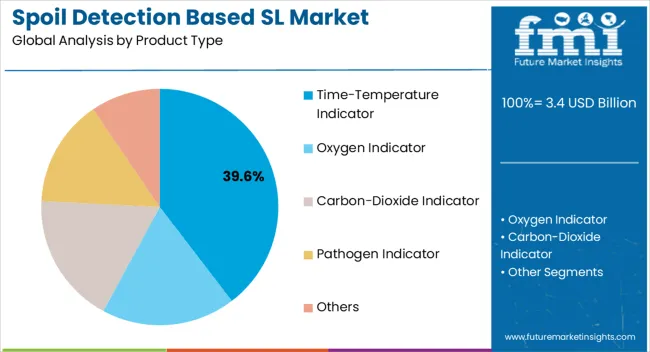
The time-temperature indicator segment is projected to hold 39.6% of the spoil detection based smart label market revenue share in 2025, positioning it as the leading product type. Its dominance is being supported by the ability to monitor and record temperature variations throughout the storage and transportation process, ensuring early detection of potential spoilage.
These indicators are valued for their cost-effectiveness and ease of integration into existing packaging systems, making them highly scalable for large-scale distribution. The growing demand for monitoring solutions that provide visual confirmation of temperature abuse is increasing adoption in industries where maintaining the cold chain is critical.
Advances in printed electronics and bio-responsive materials are improving the reliability and accuracy of these labels, further reinforcing their market share As global trade in perishable products continues to expand, the importance of temperature-sensitive monitoring tools is expected to rise, making time-temperature indicators the preferred choice for ensuring food safety, compliance, and quality assurance in distribution networks.
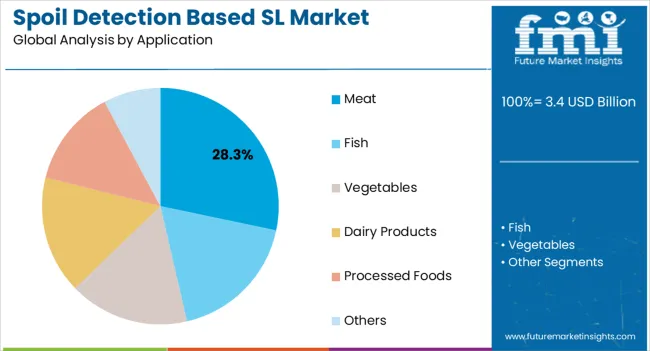
The meat application segment is expected to account for 28.3% of the spoil detection based smart label market revenue share in 2025, establishing it as the leading application. Its leadership is being driven by the high perishability of meat products, which makes them particularly vulnerable to temperature fluctuations and microbial contamination. Increasing consumer awareness of food safety risks and demand for transparency in product quality are reinforcing the need for intelligent labeling solutions in this category.
Regulatory agencies are also placing greater emphasis on traceability and spoilage prevention, encouraging wider use of spoil detection labels. Meat processors and retailers are adopting these technologies to reduce waste, enhance brand reputation, and ensure compliance with food safety standards.
Technological improvements in sensors capable of detecting freshness indicators such as pH changes, microbial growth, and chemical by-products are strengthening the functionality of smart labels for meat products As supply chains for fresh and processed meat grow more complex, the use of spoil detection labels is expected to remain critical for maintaining consumer trust and ensuring food safety.
The global market for spoil detection-based smart labels is rapidly growing and is anticipated to witness robust growth during the forecast period 2025-2026. Spoil detection-based smart labels detect the exact freshness of products and facilitate the entire process of monitoring the product spoilage in real time.
They also serve to monitor and measure the factors; temperature, pH, moisture, and microbial growth to mention the basic ones. This strong attribute is a key factor influencing the overall growth of the market.
Food materials are predicted to propel the demand for spoil detection-based smart labels. According to FMI's research, vegetables, fruits, meat, and fish will continue to drive heavy growth of the market globally. With rising adoption of smart packaging and increasing consumer population inclined toward purchasing hygienic food products, the market is expected to gain traction in the packaged food products sector.
A few developed nations are currently following strict norms related to minimal food wastage, prompting at elevated demand for spoil detection-based smart labels for virtually tracking food spoilage.
Apart from food and beverage industry, smart labels are being increasingly used in pharmaceuticals, medical and healthcare, chemical, and logistics, which is foreseen to bolster the market growth over the forecast period. Moreover, growing collaborative efforts from several private and government entities is said to play a major role in improving the quality and efficiency of products, thereby supporting the market to thrive.
In addition, favourable governmental regulations and policies will act a key driving force in strengthening the spoil detection-based smart label market globally. Increasing number of food safety standards monitoring agencies all over the globe is also an important reason for widespread adoption of smart labels.
The global spoil detection-based smart label market is segmented on the basis of product type, application, and region.
On the basis of product type, the market is further segmented into time- temperature indicator, oxygen indicator, carbon-dioxide indicator, pathogen indicator, and others. The time-temperature indicator segment holds key importance in adoption of spoil detection-based smart labels.
According to regional analysis, the global market is segmented into seven key regions, including North America, Latin America, Eastern Europe, Western Europe, Japan, Asia Pacific excluding Japan (APEJ), and Middle East and Africa (MEA). North America and Western Europe are currently having a strong hold in the market, driven by higher consumer awareness about packaged food safety and technological advancements in the food and beverages packaging industry.
APEJ is projected to witness considerable growth opportunity over the forecast period. Over the forecast period, increasing demand for packaged food products and growing consumer awareness about packaged food safety are expected to dramatically bolster the growth of spoil detection-based smart labels in the APEJ region.
The report is a compilation of first-hand information, qualitative and quantitative assessment by industry analysts, inputs from industry experts and industry participants across the value chain. The report provides in-depth analysis of parent market trends, macro-economic indicators and governing factors along with market attractiveness as per segments. The report also maps the qualitative impact of various market factors on market segments and geographies.
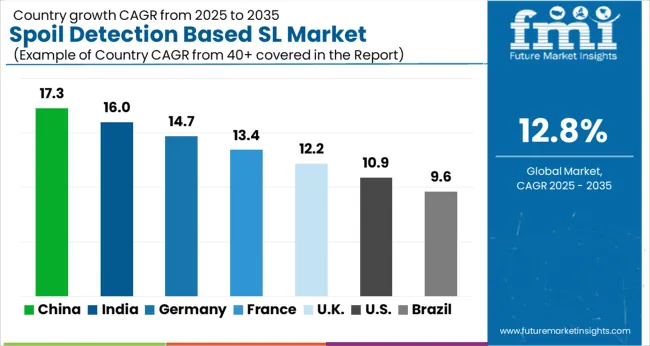
| Country | CAGR |
|---|---|
| China | 17.3% |
| India | 16.0% |
| Germany | 14.7% |
| France | 13.4% |
| UK | 12.2% |
| USA | 10.9% |
| Brazil | 9.6% |
The Spoil Detection Based Smart Label Market is expected to register a CAGR of 12.8% during the forecast period, exhibiting varied country level momentum. China leads with the highest CAGR of 17.3%, followed by India at 16.0%. Developed markets such as Germany, France, and the UK continue to expand steadily, while the USA is likely to grow at consistent rates. Brazil posts the lowest CAGR at 9.6%, yet still underscores a broadly positive trajectory for the global Spoil Detection Based Smart Label Market. In 2024, Germany held a dominant revenue in the Western Europe market and is expected to grow with a CAGR of 14.7%. The USA Spoil Detection Based Smart Label Market is estimated to be valued at USD 1.2 billion in 2025 and is anticipated to reach a valuation of USD 3.4 billion by 2035. Sales are projected to rise at a CAGR of 10.9% over the forecast period between 2025 and 2035. While Japan and South Korea markets are estimated to be valued at USD 186.6 million and USD 113.0 million respectively in 2025.
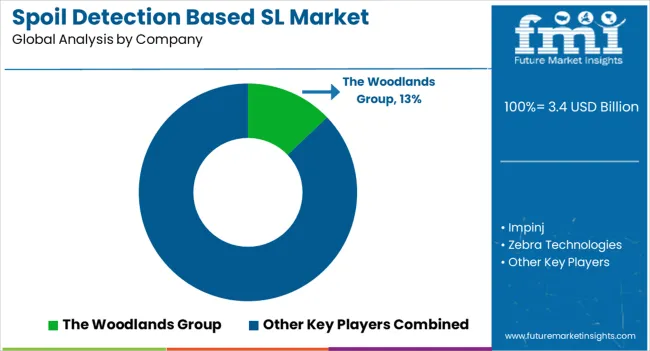
| Item | Value |
|---|---|
| Quantitative Units | USD 3.4 Billion |
| Product Type | Time-Temperature Indicator, Oxygen Indicator, Carbon-Dioxide Indicator, Pathogen Indicator, and Others |
| Application | Meat, Fish, Vegetables, Dairy Products, Processed Foods, and Others |
| Regions Covered | North America, Europe, Asia-Pacific, Latin America, Middle East & Africa |
| Country Covered | United States, Canada, Germany, France, United Kingdom, China, Japan, India, Brazil, South Africa |
| Key Companies Profiled | The Woodlands Group, Impinj, Zebra Technologies, Thin Film Electronics, Dualro, Cognex Corporation, Locus Traxx, Sensory Technology, Avery Dennison Smartrac, Smart label Solutions, Avery Dennison, NXP Semiconductors, Smartrac Technology, Wiliot, and OmniID |
The global spoil detection based smart label market is estimated to be valued at USD 3.4 billion in 2025.
The market size for the spoil detection based smart label market is projected to reach USD 11.5 billion by 2035.
The spoil detection based smart label market is expected to grow at a 12.8% CAGR between 2025 and 2035.
The key product types in spoil detection based smart label market are time-temperature indicator, oxygen indicator, carbon-dioxide indicator, pathogen indicator and others.
In terms of application, meat segment to command 28.3% share in the spoil detection based smart label market in 2025.






Our Research Products

The "Full Research Suite" delivers actionable market intel, deep dives on markets or technologies, so clients act faster, cut risk, and unlock growth.

The Leaderboard benchmarks and ranks top vendors, classifying them as Established Leaders, Leading Challengers, or Disruptors & Challengers.

Locates where complements amplify value and substitutes erode it, forecasting net impact by horizon

We deliver granular, decision-grade intel: market sizing, 5-year forecasts, pricing, adoption, usage, revenue, and operational KPIs—plus competitor tracking, regulation, and value chains—across 60 countries broadly.

Spot the shifts before they hit your P&L. We track inflection points, adoption curves, pricing moves, and ecosystem plays to show where demand is heading, why it is changing, and what to do next across high-growth markets and disruptive tech

Real-time reads of user behavior. We track shifting priorities, perceptions of today’s and next-gen services, and provider experience, then pace how fast tech moves from trial to adoption, blending buyer, consumer, and channel inputs with social signals (#WhySwitch, #UX).

Partner with our analyst team to build a custom report designed around your business priorities. From analysing market trends to assessing competitors or crafting bespoke datasets, we tailor insights to your needs.
Supplier Intelligence
Discovery & Profiling
Capacity & Footprint
Performance & Risk
Compliance & Governance
Commercial Readiness
Who Supplies Whom
Scorecards & Shortlists
Playbooks & Docs
Category Intelligence
Definition & Scope
Demand & Use Cases
Cost Drivers
Market Structure
Supply Chain Map
Trade & Policy
Operating Norms
Deliverables
Buyer Intelligence
Account Basics
Spend & Scope
Procurement Model
Vendor Requirements
Terms & Policies
Entry Strategy
Pain Points & Triggers
Outputs
Pricing Analysis
Benchmarks
Trends
Should-Cost
Indexation
Landed Cost
Commercial Terms
Deliverables
Brand Analysis
Positioning & Value Prop
Share & Presence
Customer Evidence
Go-to-Market
Digital & Reputation
Compliance & Trust
KPIs & Gaps
Outputs
Full Research Suite comprises of:
Market outlook & trends analysis
Interviews & case studies
Strategic recommendations
Vendor profiles & capabilities analysis
5-year forecasts
8 regions and 60+ country-level data splits
Market segment data splits
12 months of continuous data updates
DELIVERED AS:
PDF EXCEL ONLINE
Smart Label Market Size and Share Forecast Outlook 2025 to 2035
Smart Labelling in Logistics Market Size and Share Forecast Outlook 2025 to 2035
Market Share Insights for Smart Label Providers
Smart Home-Based Beverage Machine Market Size and Share Forecast Outlook 2025 to 2035
Smart Plant Based Food Packaging Market Size and Share Forecast Outlook 2025 to 2035
NGS-based AMR Detection Market Analysis Size and Share Forecast Outlook 2025 to 2035
AI-based Atrial Fibrillation AFib Detection Market Size and Share Forecast Outlook 2025 to 2035
Veterinary CRISPR-Based Detection Kits Market Size and Share Forecast Outlook 2025 to 2035
Smart Meeting Pod Market Size and Share Forecast Outlook 2025 to 2035
Smart Electrogastrogram Recorder Market Size and Share Forecast Outlook 2025 to 2035
Smart Aerial Work Robots Market Size and Share Forecast Outlook 2025 to 2035
Smart Bladder Scanner Market Size and Share Forecast Outlook 2025 to 2035
Smart School Bus Platform Market Size and Share Forecast Outlook 2025 to 2035
Smart Home Wireless Smoke Detector Market Size and Share Forecast Outlook 2025 to 2035
Smart Bus Platform Market Size and Share Forecast Outlook 2025 to 2035
Smart Vision Processing Chips Market Size and Share Forecast Outlook 2025 to 2035
Smart Touch Screen Scale Market Size and Share Forecast Outlook 2025 to 2035
Smart Magnetic Drive Conveyor System Market Size and Share Forecast Outlook 2025 to 2035
Smart Wheelchair market Size and Share Forecast Outlook 2025 to 2035
Smart Mining Technologies Market Size and Share Forecast Outlook 2025 to 2035

Thank you!
You will receive an email from our Business Development Manager. Please be sure to check your SPAM/JUNK folder too.
Chat With
MaRIA